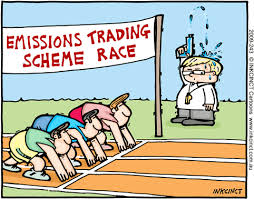California Senate President Pro Tempore Kevin de Leon added a new twist (climate change) to the increasingly popular topic of the “energy-water nexus.” Speaking at the 30th Annual Meeting and Dinner of the Southern California Water Committee, “as we live through the current severe and extreme drought, which is now approaching a 4th straight year of drought conditions, the realities of limited water supplies are hitting home.” Introducing climate change into the policy discussion, Senator de Leon will move water agencies into a new era of carbon emission control. Will participation in California’s cap-and-trade emission market become a new tool for water managers?
The Traditional Energy-Water Nexus
An Energy-Water Nexus of the past few years has focused on the fact that significant quantities of energy are required to pump groundwater and convey water through pipelines or aqueducts. At the same time, water is an essential input for energy production. This latter point is well demonstrated in the marketplace. Hydrowonk works in states where water sells at more than a couple of dollars per barrel of water (42 gallons)—that is, between $15,000/AF to $20,000/AF. The water and energy sectors covet each other’s output.
Enter Climate Change
President Pro Tempore de Leon links California’s current drought to climate change. Based on a recent report issued by Stanford University’s Woods Institute for the Environment, Senator de Leon observed:
- “the current California drought is ‘very likely’ linked to climate change, contributing to the creation of the stubborn high-pressure system that is fending away rainstorms over California”
- “the more greenhouse gas emissions we produce the more we harm the state’s water supply from climate change. It’s a vicious circle.”
Senator de Leon sees laying the foundation of a green economy as a top priority. California’s eight year old greenhouse reduction law (AB 32) sets a pathway for reduced emissions (achieve 1990 emission levels by 2020), cleaner energy and a cap-and-trade program for emissions that set a price for carbon pollution. “Our failure to reduce greenhouse gas emissions results in exacerbation of our drought conditions.”
Offering a call to action, Senator de Leon said: “We are serious about combatting climate change, which I believe we must be, we must also ensure we are using cleaner energy for water production . . .” “We need to work together to better hardwire greenhouse emissions reductions and cleaner energy considerations into state and local water agency decisions.”
Finally, “as the state continues to appropriate funding from cap-and-trade revenues, we need to utilize these funds to provide incentives to help our water agencies make the transition to a low-carbon economy.”
Hydrowonk’s Take
Paraphrasing Rahm Emanuel, “never let a severe drought go to waste.” California faces significant risk of multiple-year droughts, but climate change may not be the culprit. DWR’s tree-ring study for the Sacramento River showed no trend in the 100-year running average of the Sacramento River Four Rivers unimpaired runoff for the period 900 through 2012 (eleven plus centuries)—see Chart. So much for the impact of climate change.
The data does show that, if one is in the third year of unusually low runoff, there is a significant risk (54%) that unimpaired runoff will be unusually low in the fourth year. If the drought conditions continue for a fourth year (is this an emerging consensus?), then there is still a significant risk (53%) that severe conditions could extend for a fifth year. Look for the climate change narrative to intensify.
Bringing the water industry into the green economy fold may, as usual, be a double-edged sword. Look for regulatory requirements on clean energy to filter into water agency programs. As these occur, water agency costs may spiral up like the electric utilities costs of incorporating “cleaner” energy into their operations.
Yet, there is another opportunity. Under AB 32, greenhouse gas offsets can be secured from regulatory recognition of reductions in greenhouse emissions in an activity not already subject to limits under AB 32. Water project and operations can impact greenhouse gas and other pollutants subject to federal and state regulation. If there is regulatory acceptance that water industry activities are reducing greenhouse gas and other pollutants, then emission credits can be created and sold in the cap-and-trade market. This would provide a new revenue stream for the water industry.
As in all challenges in life, there are two ways one can approach the move by Senator de Leon to link climate change to the drought: debate or create. Debaters can parse the claims about drought (DWR’s tree ring study of the Sacramento River could be Exhibit A). Creators can see a new market opportunity for the water industry. On this one, Hydrowonk wants to create, not debate.


